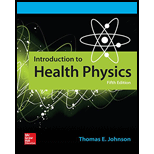
Concept explainers
(a)
The voltage required to accelerate the proton.
(a)
Answer to Problem 2.15P
The voltage required to accelerate the proton from zero velocity to a velocity corresponding to a de Broglie wavelength of
Explanation of Solution
Given:
De-Broglie Wavelength,
Mass of the proton,
Initial velocity,
Formula used:
The de-Broglie wavelength of the particle is given as
Here,
Calculation:
Calculating the velocity of the proton corresponding to a wavelength of
Plugging the values in the above equation:
We need to check whether the relativistic effect is important
The voltage required to accelerate the proton from zero velocity to a velocity corresponding to a de Broglie wavelength of
Conclusion:
Thus,the voltage required to accelerate the proton from zero velocity to a velocity corresponding to a de Broglie wavelength of
(b)
The kinetic energy of an electron corresponding to a de Broglie wavelength of
(b)
Answer to Problem 2.15P
The kinetic energy of an electron corresponding to a de Broglie wavelength of
Explanation of Solution
Given:
De-Broglie Wavelength,
Mass of the electron,
Formula used:
Kinetic energy is given as
Here,
Calculation:
The velocity of the electron corresponding to a wavelength of
Plugging the values in the above equation
Since the speed of the electron is greater than the speed of light in a vacuum, therefore, we need to consider the effect of relativity
We need to check whether the relativistic effect is important
The kinetic energy of the electron corresponding to a wavelength of
Conclusion:
The kinetic energy of an electron corresponding to a de Broglie wavelength of
(c)
The energy of an X-ray photon corresponding to a wavelength of
(c)
Answer to Problem 2.15P
The energy of an X-ray photon corresponding to a wavelength of
Explanation of Solution
Given:
Wavelength,
Formula used:
The energy of a photon is given as:
Here,
Calculation:
The energy of a photon is given as
Plugging the values in the above equation
Conclusion:
The energy of an X-ray photon corresponding to a wavelength of
Want to see more full solutions like this?
Chapter 2 Solutions
EBK INTRODUCTION TO HEALTH PHYSICS, FIF
- (a) For a spherical capacitor with inner radius a and outer radius b, we have the following for the capacitance. ab C = k₂(b- a) 0.0695 m 0.145 m (8.99 × 10º N · m²/c²)( [0.145 m- 0.0695 m × 10-11 F = PF IIarrow_forwardA pendulum bob A (0.5 kg) is given an initialspeed of vA = 4 m/s when the chord ishorizontal. It then hits a stationary block B (1kg) which then slides to a maximum distanced before it stops. Determine the value of d.The coefficient of static friction between theblock and the plane is μk = 0.2. The coefficientof restitution between A and B is e = 0.8.Ans: d=1.0034 marrow_forwardFigure 29-43 Problem 12. ••13 In Fig. 29-44, point P₁ is at distance R = 13.1 cm on the perpendicular bisector of a straight wire of length L = 18.0 cm carrying current i = 58.2 mA. (Note that the wire is not long.) What is the magnitude of the magnetic field at P₁ due to i? P2° R R Larrow_forward
- Checkpoint 1 The figure shows the current i in a single-loop circuit with a battery B and a resistance R (and wires of neg- ligible resistance). (a) Should the emf arrow at B be drawn pointing leftward or rightward? At points a, B C R b, and c, rank (b) the magnitude of the current, (c) the electric potential, and (d) the electric potential energy of the charge carriers, greatest first.arrow_forwardPls help ASAParrow_forwardPls help asaparrow_forward
 Modern PhysicsPhysicsISBN:9781111794378Author:Raymond A. Serway, Clement J. Moses, Curt A. MoyerPublisher:Cengage Learning
Modern PhysicsPhysicsISBN:9781111794378Author:Raymond A. Serway, Clement J. Moses, Curt A. MoyerPublisher:Cengage Learning University Physics Volume 3PhysicsISBN:9781938168185Author:William Moebs, Jeff SannyPublisher:OpenStax
University Physics Volume 3PhysicsISBN:9781938168185Author:William Moebs, Jeff SannyPublisher:OpenStax Physics for Scientists and Engineers with Modern ...PhysicsISBN:9781337553292Author:Raymond A. Serway, John W. JewettPublisher:Cengage Learning
Physics for Scientists and Engineers with Modern ...PhysicsISBN:9781337553292Author:Raymond A. Serway, John W. JewettPublisher:Cengage Learning Glencoe Physics: Principles and Problems, Student...PhysicsISBN:9780078807213Author:Paul W. ZitzewitzPublisher:Glencoe/McGraw-Hill
Glencoe Physics: Principles and Problems, Student...PhysicsISBN:9780078807213Author:Paul W. ZitzewitzPublisher:Glencoe/McGraw-Hill Principles of Physics: A Calculus-Based TextPhysicsISBN:9781133104261Author:Raymond A. Serway, John W. JewettPublisher:Cengage Learning
Principles of Physics: A Calculus-Based TextPhysicsISBN:9781133104261Author:Raymond A. Serway, John W. JewettPublisher:Cengage Learning College PhysicsPhysicsISBN:9781305952300Author:Raymond A. Serway, Chris VuillePublisher:Cengage Learning
College PhysicsPhysicsISBN:9781305952300Author:Raymond A. Serway, Chris VuillePublisher:Cengage Learning





